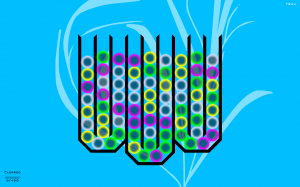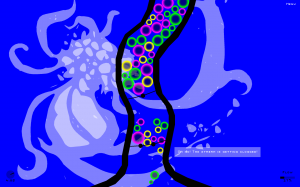Chains: Easy Mode
I was starting to think I had underestimated this game. It looked like a match-3 with a gimmick, but it was actually turning out to be a puzzle game in the truest sense of the word: something where you have to figure out solutions. The randomization means that the solutions aren’t move-by-move precise like in a chess problem, of course. They’re tactical solutions, approaches that yield better results. But they’re still things that you have to figure out. For example, in the “Coathanger” level that I mentioned last post, the key things I figured out were: (a) it’s important to alternate sides so that the coathanger doesn’t start swinging too wildly and throwing things off, (b) it’s better to make chains on the inside, where there’s pressure keeping the bubbles from rolling away while you’re trying to link them, and (c) contrary to what you might think, it’s better to delete stuff on the side that’s currently on the upswing, because that way the loose bubbles roll away from the edge.
But then, the moment I decide that this game is richer than it appears, it starts repeating itself, and worse, starts giving me tactically simple levels, with stable architecture, where the only possible approach is just finding chains as quickly as possible. This isn’t the sort of challenge I want, so I finally give in and drop down to “Beginner” difficulty level to get by them.
It’s actually pretty hard to notice exactly what the difficulty level changes. Turning the difficulty down definitely makes things easier, but it doesn’t do it in the more obvious ways, like making the bubbles fall slower or reducing the number of bubble colors. I’m pretty sure it affects the maximum link-length — that is, the easier the setting, the farther apart the bubbles in a chain can be. This alone makes a tremendous difference: far too many times have I wasted precious moments trying to make a chain whose third link turns out to be just out of reach.
I’m not completely sure of this, because my attention while playing is mainly on pursuit of goals, but it seems to me that easy mode also makes the bubbles exert a slight magnetic attraction on one another, so that they cluster together more easily in nice tight packs. This is hard to judge because gravity tends to do the same to them, given enough time to work. But it’s definitely the sort of thing that would help, keeping bubbles in easily chainable formations instead of drifting apart. But it’s definitely a subtle effect. It makes me wonder a little about Medium difficulty. Am I receiving help there that I’m unaware of? If I switched to Hard now, would I start noticing it?
 Comments(0)
Comments(0)

